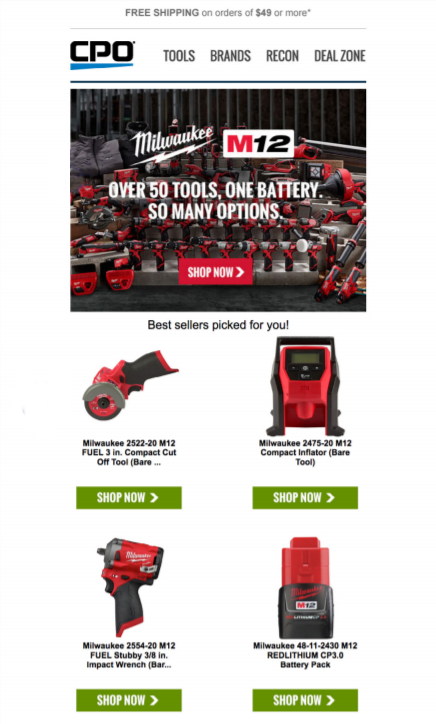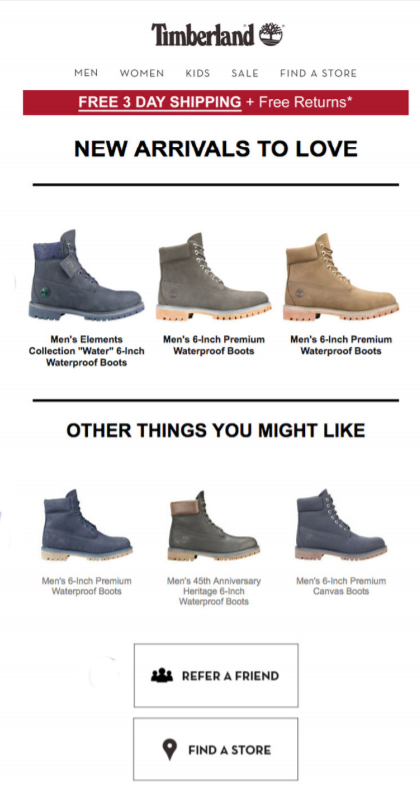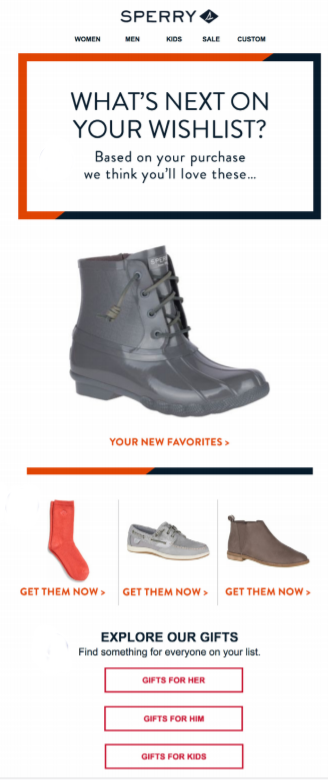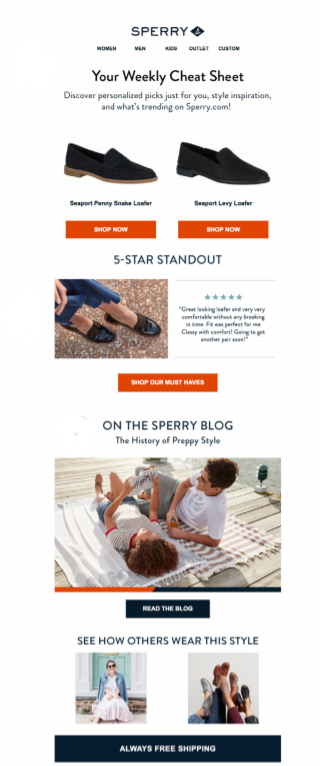Product recommendations: 6 best practices to drive conversions
As a retailer, you use all kinds of merchandising tactics in your brick-and-mortar stores to give customers a high quality experience while driving sales. You’ll hire a merchandiser to strategically place products throughout your store, train sales associates to help shoppers find the perfect product and do whatever else it takes to create a happy customer. After all, for a retailer, satisfying customers and generating sales is the name of the game.
However, in recent years, more and more shoppers have started to shop online — and digital experiences need to emulate the personal brick-and-mortar experience online. This is where intelligent product recommendations come in.
When a shopper engages with your brand, whether it’s on your website, in their email inbox, on social channels or anywhere else, they should see a range of products tailored to their interests. When done correctly, these product recommendations can help expand customers’ cart sizes or even inspire product discovery to spur new purchases. Consequently, product recommendations and the recommendation engines that drive them have become an absolute must-have for ecommerce retailers, ranging from Amazon to big-box retailers to new, niche shops.
While you may be familiar with product recommendations, making the most of them isn’t always intuitive. Let’s examine what a product recommendations really entail, what benefits they bring and how your brand can start recommending products today.
[ Download our 2022 Retail Email Benchmark Report ]
What is a Product Recommendation?
Product recommendations provide a short list of products that a shopper is likely to be interested in, by matching customer and behavioral data to the product data from items in your catalog. These systems help shoppers discover products they’ll love, all with the aim of driving continued purchases and cementing customer loyalty.
Product recommendations can be as simple as showing a list of best selling items to every customer or as sophisticated as 1:1 product recommendations that mesh a customer’s attributes, browsing behavior, and predicted affinities with the characteristics of products in your catalog. Advanced product recommendation engines use AI to automatically and intelligently recommend individual products from your catalog using existing customer data. This grants your marketing team access to unique recommendations that would be difficult or impossible for a human to uncover.
These recommendations can appear multiple times across a shopper’s journey, ranging from the home page and product pages on your ecommerce site to the shopping cart and follow-up emails to even 404 pages. So long as a shopper views an email or webpage that you own, your product recommendation engine can automatically and instantly tempt them into adding another item to their cart.
The benefits behind product recommendations
On a basic level, one benefit behind product recommendations is abundantly clear – they help shoppers find items that they’re looking for without requiring much ongoing effort from the customer or your marketing team. However, if you want to enjoy all of the benefits behind product recommendations, you need to augment them with personalization.
For instance, personalized product recommendations are a huge contributor to Amazon’s success, generating 35% of their total retail revenue. Successful retailers like Hammacher Schlemmer have also managed to improve their email campaign revenue by 28x using personalized product recommendations.
With so much money on the table, personalized product recommendations aren’t just a value-add — they’re a necessity. Additionally, surveys reveal that 63% of consumers expect personalization as a part of their online experience, and 91% of consumers prefer to shop with brands that consistently provide them with relevant offers and recommendations.
Providing these relevant offers and recommendations requires the adept use of three types of data: Customer, behavior, and product data. These data points help retailers understand three key attributes about shoppers: Who they are (customer data), what they want (product data), and when they want it (behavioral data). Introducing a product recommendation engine that analyzes customer, behavior, and product data can enable your team to connect shoppers to relevant products when they’re most likely to need them.
To sum up all the benefits, investing in a retail-specific personalized product recommendation engine will provide the exemplary shopping experience that customers have come to expect, while driving an incredible amount of revenue.
How to use product recommendations
There are several different types of product recommendations that your team can use across various touchpoints. For instance, your marketing team can place a set of product recommendations in an email, within a product page, or even as an onsite pop-up. Generally, you should place them in a spot that is conspicuous without drowning out more important elements within the page or email.
Next, you need to make sure these recommendations are relevant to the individual customers who see them – and this requires introducing personalization. While personalization isn’t absolutely essential to providing product recommendations per se, static product recommendations have the potential to annoy customers while driving a fraction of the conversions compared to personalized product recommendations.
The best way to ensure your recommendations are relevant for each customer is to choose a product recommendation engine that is built on a modern, retail-specific data model. For example, a model that uses customer, behavior, and product data would score a customer’s likelihood to be interested in a certain category using customer data and match that with new products using product data. Then, the model would use behavior data to further narrow your audience to include customers with a high likelihood to purchase in the next three days. The outcome will be individualized, timely recommendations that prompt a consumer to take action.
The difference between using static recommendations and agile personalized product recommendations is like night and day. While impersonal recommendations are usually bland and don’t incite customers to jump into action, personalized product recommendations that cater to each individual shopper’s interests help boost engagement and drive product discovery in a way that encourages these customers to continue buying from your brand over time.
Importantly, your product recommendation solution should discourage bottlenecks in purchasing by using automation to produce recommendations on a near-instant basis. If your team needs to wait days or even weeks to manually configure a personalized campaign, you will likely miss multiple opportunities. For this reason, you can’t settle for manual workflows if you’d like consistently relevant campaigns. Instead, you need a self-learning retail marketing solution that will let you start offering personalized product recommendations as soon as customers start showing interest.
In order to make the most of your product recommendation strategy, it’s helpful to study a few examples of how they work in practice. Let’s dive into some of the most impactful ways that your retail marketing team can power product recommendations.
1. Best sellers

Showcasing your best sellers is a great way to increase sales from customers. When placing these product recommendations, put them in high-visibility locations that won’t impede a shopper’s ability to navigate the page or view the content in your email. This will ensure that your recommendations are seen as a helpful asset to customers, not a blatant promotion.
Imagine if a new customer was browsing your store and they immediately navigated to your “Women’s Tops” category. Since you know little about them, your initial welcome email should include recommendations with your top-selling shirts for women. If they ignore these recommendations and begin browsing different styles of striped long sleeve shirts, then your next recommendation should include best-selling long sleeve shirts, shirts with stripes and other similar products. These types of recommendations will help customers find what they’re looking for and might even encourage them to purchase multiple articles of clothing.
2. New arrivals

New arrival recommendations promote products that are new to your catalog. While this type of recommendation can be as simple as showing new products from the last 24 hours, 7 days, or 30 days, personalizing new arrival recommendations can maximize conversions. For example, your team can layer these recommendations with a customer’s category or product preferences to ensure each individual customer sees the items that they’ll find most interesting.
Imagine if one of your customers regularly purchases jackets and coats from your store. With a simple new arrival recommendation, they would see a general list of all new products that were added in the past week. By personalizing this recommendation, however, this customer can receive a recommendation that’s populated specifically with your newest outerwear, which offers a much better chance of piquing their interest.
3. Interaction history

Every time a consumer interacts with a brand online, they leave data behind — and your team can use that data to provide personalized recommendations. Specifically, an AI-driven system can predict what products a customer is likely to be interested in by examining their previous actions, such as products they viewed, searched for, carted, purchased or otherwise interacted with.
Imagine if a consumer viewed vinyl records, headphones and speakers on your website. At this point, your product recommendation engine could begin showing the customer dynamic recommendations for various audio accessories. This could include more vinyl records and different kinds of speakers, but it may also include a turntable since it matches their previous browsing habits.
4. Co-recommendations

Co-recommendations use collaborative filtering to suggest products based on the actions of other users. When a user enters your online store, they’ll be shown recommendations based on what shoppers with similar activity viewed, searched, carted or purchased. This allows you to provide intelligent, personalized product recommendations even if you don’t have a wealth of data about the customer.
For instance, think of a customer who only visits your store to buy a similar style of denim pants despite your store offering a range of apparel. Since they only view and purchase pants, you don’t want to recommend more pants — it’s better to make them a cross-category shopper. So your engine could find clothes that similar customers liked, like a fashionable jacket or a durable pair of boots. If they choose to purchase one of these products, it could expand their interest in your brand while also increasing their potential order size.
5. Dynamic recommendations

Dynamic recommendations provide a range of choices for product recommendations. They can be layered with other types of product recommendations to show a specific product lineup to certain customers. This approach is ideal if you want to make the most of your extensive knowledge of certain customer segments.
For example, a shopper may begin viewing and carting a range of inexpensive toys during the holiday season. To capitalize on their interests, you could cater a dynamic recommendation that shows them more inexpensive gift suggestions for children. Simply filter by toys, books, crafts or a similar criteria, ensure their price is less than $10 and sort by “best sellers” or “new arrivals.”
6. Next best purchase
Recommendations that determine a customer’s next best purchase require a wealth of product and customer data to function, but they have a high potential to convert among returning customers.
To provide a next best purchase recommendation, the recommendation engine will reference a shopper’s activity and discern all of the product attributes in which they are interested. Then, the engine will automatically run that information through your current product catalog to find every product that matches that attribute. Finally, the engine will evaluate common purchasing patterns to determine the best time to deliver the product recommendation. Over time, you can even evaluate previous recommendations to identify trends, tweak your existing retail data model and optimize results.
For instance, take a look at the patterns that one clothing retailer found:

Judging by this chart, if a customer intends to purchase a shirt, they have a 15% chance of purchasing another shirt and an 11% chance of purchasing denim as their next item. Knowing this, your recommendation engine would start showing denim alongside shirts to encourage them to make another purchase.
More personalization garners more success
Product recommendations encourage cross-selling and upselling among shoppers — however, retailers that want to stay contemporary and competitive need to imbue their recommendations with personalization. When you can personalize product recommendations at the 1:1 level, you can ultimately drive more conversions while solidifying customer loyalty.
Thankfully, retailers no longer need to build their own personalized recommendation engines from scratch, nor do they need to spend a lot of time manually feeding product or customer information into an engine. Today, retailers should search for a purpose-built retail marketing solution that will allow them to build these recommendations from the ground-up right away so they can start enjoying the benefits today.


